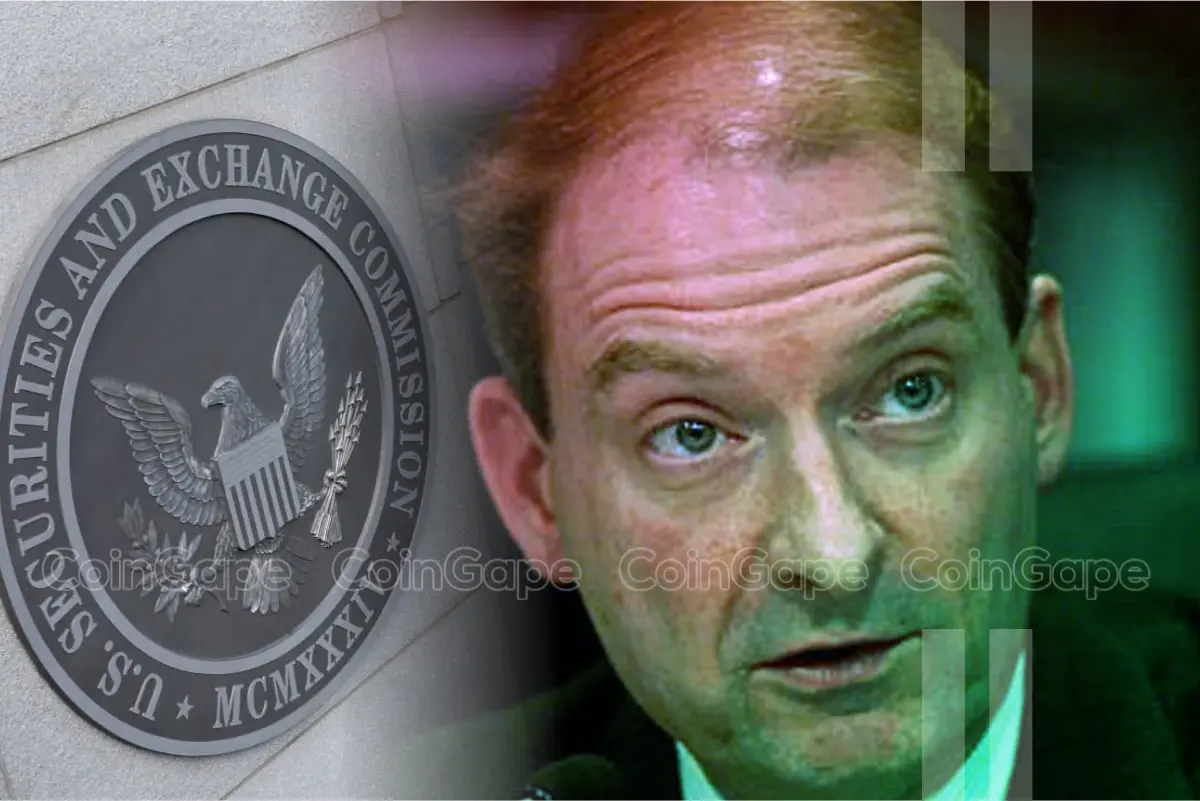Bitcoin
Is Bitcoin (BTC) Bull Run Stalling? CryptoQuant CEO Expects A Rebound In Q4

Bitcoin is currently facing a critical test, having retraced over 19% from local highs and holding above a key demand level around $54,000 that supports the market structure. This level represents the last line of defense for BTC, and if it breaks, a deeper correction could be in play.
Analysts and investors are actively sharing their insights, with many looking at market data to assess Bitcoin’s next move. CryptoQuant CEO, Ki Young Ju, recently shared crucial data that sheds light on the current situation. His analysis highlights on-chain metrics that provide a clearer understanding of why Bitcoin is struggling to maintain its value.
Additionally, he has made a prediction for Bitcoin’s performance in the final months of the year, outlining what investors should watch for as market conditions evolve. As the year progresses, these insights could help guide market participants as they navigate the volatility surrounding Bitcoin’s price action.
US Demand Crucial For Bitcoin Bull Run
Bitcoin (BTC) is currently experiencing significant selling pressure, largely attributed to a notable decline in demand. Recent data shared by Ju, reveals that Coinbase’s Bitcoin spot trading volume dominance has reverted to pre-spot ETF levels. This shift highlights a substantial dip in US demand, a crucial factor for sustaining the bullish momentum seen earlier this year.

Ju emphasizes that for Bitcoin’s bull cycle to regain its strength, a rebound in US demand is essential. He projects that this recovery might occur in the fourth quarter of 2024, suggesting that we are currently in the midst of the market cycle without having reached the retail bubble phase. This perspective implies that there remains ample opportunity for growth as the market progresses.
The current phase reflects a consolidation period rather than a terminal decline, indicating that Bitcoin’s price dynamics are subject to fluctuations as demand trends shift. Investors should be aware that while short-term pressure is evident, the potential for a significant rebound exists if demand conditions improve as anticipated. As the market continues to evolve, keeping an eye on these demand metrics will be crucial for understanding Bitcoin’s future trajectory.
BTC Technical Details
Bitcoin is currently trading at $54,404, maintaining a critical support level that is keeping its price within a reasonable accumulation pattern. This level is crucial for preventing further declines. If BTC fails to hold this support, a deeper correction could be on the horizon.
At present, BTC is trading below the 4-hour 200 moving average (MA), which stands at $59,263. Reclaiming and holding this level as support is essential for shifting market sentiment and reviving bullish momentum. A decisive break above $60,000 would likely spark renewed demand and potentially drive the price higher.

Conversely, if Bitcoin loses its current support and falls below $54,404, it could signal a move towards lower demand zones, with $49,000 emerging as a key target for further testing. This scenario would indicate a bearish shift in the market, necessitating close monitoring of price movements to gauge future trends. The ability to hold above the $54,404 level and reclaim the 200 MA will be critical for determining BTC’s short-term outlook and potential for recovery.
Featured image from Dall-E, chart from TradingView
Bitcoin
BlackRock Approved by FCA to Operate as UK Crypto Asset Firm

BlackRock, the world’s largest asset manager, received approval from the UK’s Financial Conduct Authority (FCA) to operate as a crypto asset firm.
This marks a significant milestone for the investment giant, allowing it to extend its influence in the growing digital asset market.
BlackRock Joins Crypto Elite with FCA Approval in the UK
With this approval, BlackRock can operate its newly launched European Bitcoin exchange-traded product (ETP) as a UK entity.
According to the FCA’s website, BlackRock officially became the 51st company registered as a crypto asset firm on April 1, 2025. The firm joins a select group of financial entities, including Coinbase, PayPal, and Revolut, which have met the FCA’s stringent regulatory requirements.
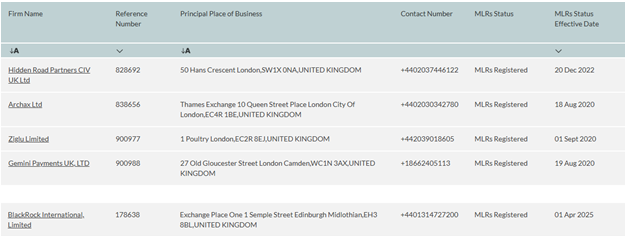
BlackRock’s iShares Bitcoin ETP recently launched on the Euronext stock exchanges in Paris and Amsterdam. As BeInCrypto reported, this marked an expansion of the firm’s footprint in the European crypto investment market.
To attract investors, the product was introduced with a temporary fee waiver. It reduced its expense ratio to 0.15% until the end of the year. Once the waiver expires, the fee will revert to 0.25%, aligning with competing products like CoinShares’ Bitcoin ETP.
The iShares Bitcoin ETP is designed for institutional and informed retail investors. It offers a regulated and cost-effective way to gain exposure to Bitcoin. This move also positions BlackRock as a leader in the European digital asset space, catering to the growing demand for crypto-based financial products.
Meanwhile, the FCA has faced criticism for its cautious approach to crypto regulation. It has only approved around 9% of all applicants seeking registration as crypto asset firms.
“This low level of application approval signifies potential concern for the UK’s ambition to become a crypto hub,” Alan Vey, founder of web3 firm Aventus and a former Brevan Howard developer, said recently.
The regulator has defended its strict policies. A statement on its website articulated that many submissions lack essential information or fail to meet compliance standards.
“We have rejected submissions that didn’t include key components necessary for us to carry out an assessment, or the poor quality of key components meant the submission was invalid,” the FCA wrote.
Therefore, BlackRock’s FCA approval is not a mean feat. It marks another step in the mainstream adoption of crypto. With the UK now part of BlackRock’s growing crypto asset operations, the firm continues to push forward in integrating Bitcoin into traditional finance (TradFi).
BlackRock also manages approximately $12 trillion in assets (AUM) and continues actively expanding its crypto market presence. It launched its iShares Bitcoin Trust (IBIT) in the US in January 2024. The financial instrument has since grown into the largest US spot Bitcoin ETF, managing nearly $49 billion in assets.
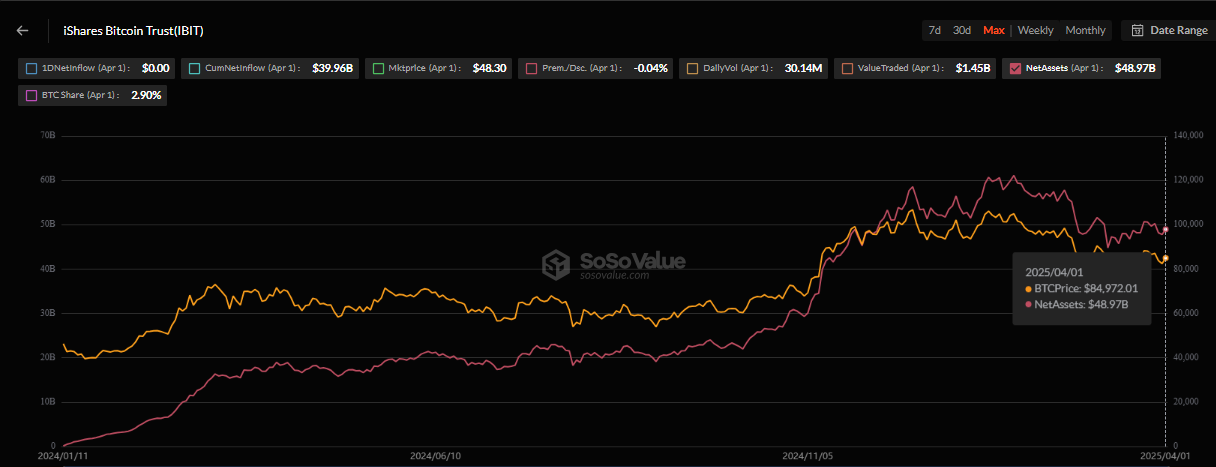
Moreover, the surge in institutional interest in Bitcoin ETFs has been remarkable. In just one year, US spot Bitcoin ETFs have attracted over $95 billion in investments, SoSoValue data shows. This highlights the increasing demand for regulated Bitcoin investment vehicles.
Disclaimer
In adherence to the Trust Project guidelines, BeInCrypto is committed to unbiased, transparent reporting. This news article aims to provide accurate, timely information. However, readers are advised to verify facts independently and consult with a professional before making any decisions based on this content. Please note that our Terms and Conditions, Privacy Policy, and Disclaimers have been updated.
Bitcoin
What It Means for Bitcoin

An expert has cautioned that the reverse yen carry trade is currently unfolding, albeit at a slower and more controlled pace.
This could have significant implications not only for traditional financial markets but also for cryptocurrencies like Bitcoin (BTC).
Why Investors Should Pay Attention to the Yen Carry Trade?
For context, the yen carry trade is a strategy in which investors borrow yen at low interest rates and invest the funds in higher-yielding assets, such as the US dollar or technology stocks. The goal is to profit from the difference in interest rates.
Nonetheless, this strategy’s risk arises from currency fluctuations. If the yen appreciates, investors converting the investment back to yen to repay the loan may see reduced or eliminated profits.
According to Michael A. Gayed, this scenario appears to be materializing now.
“The problem today is that those borrowing costs are starting to get more expensive. Traders who were able to access virtually free capital for years are now finding themselves sitting on costly margin positions that they’re potentially being forced to unwind,” he said.
In his recent report, Gayed explained that rising borrowing costs compel traders to offload dollar-denominated assets. This, in turn, heightens market volatility and depresses the prices of risk assets.
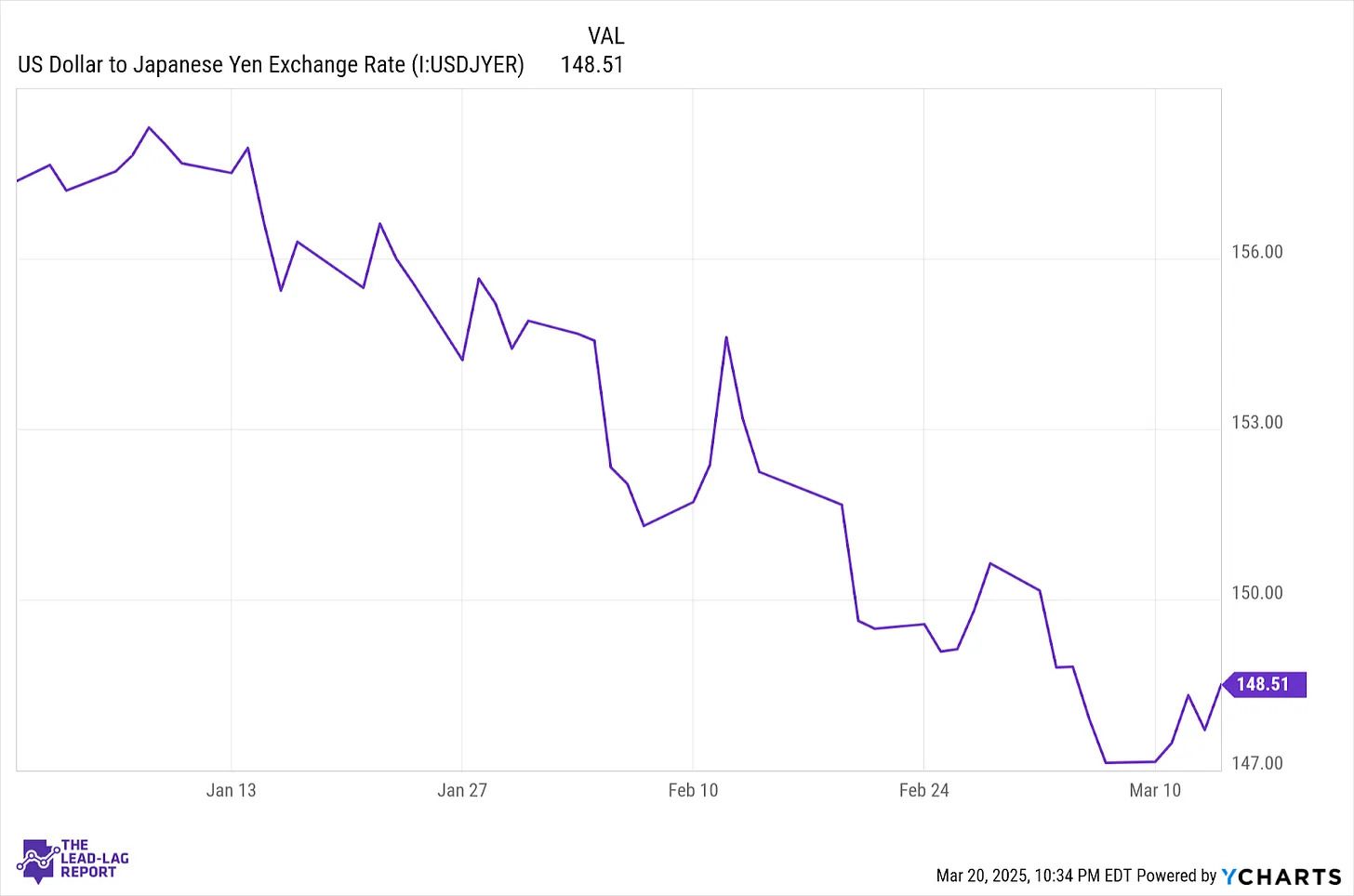
Notably, this happened last year as well. Gayed pointed out that in August 2024, the Bank of Japan’s decision to raise interest rates twice sparked a significant rally in the yen. Yet, at the same time, the S&P 500 saw an approximate 10% correction.
He added that the subsequent rebound alleviated investor concerns. Nevertheless, he believes the real issue is that the situation was never fully resolved.
“Big carry trade unwinds don’t just last a couple of weeks, and conditions are suddenly normalized,” Gayed stressed.
He added that the current market conditions resemble a similar situation. Notably, the Japanese 10-year yield has surged to 1.56%, the highest since 2008. As these yields climb, the yen strengthens, and the carry trade dynamics begin to shift.
“The 10-year yield continues to climb higher and close the interest rate differential on comparable 10-year US Treasury yields. That’s going to continue fueling strength in the yen that may continue into the later stages of 2025. And as long as the yen continues to strengthen, whether it’s quickly and slowly, that’s going to keep unwinding any outstanding carry trade that’s still out there. And it’s probably a lot,” he stated.
Moreover, Gayed suggested that the Bank of Japan will likely continue raising rates. Meanwhile, the Fed might possibly lower them in the coming months, further solidifying his outlook.
He also focused on the correlation between the S&P 500 and the yen. Gayed noted that the yen’s rise preceded the recent S&P 500 pullback by several weeks.
The correction could also be linked to an anticipated US growth slowdown and potential tariffs. Yet, he emphasized that the reverse carry trade is particularly risky due to its potential to escalate quickly, especially in the current macroeconomic climate.
“The market is plenty capable of correcting on its own, given the fears associated with tariffs and slowing economic growth. If you add people being forced to sell their US equity holdings in order to close out their short yen positions on top of that, it’s easy to see how a bad situation quickly becomes worse. And it’s already happening. Japan is still the real risk,” he claimed.
Now, the question is, why will this impact Bitcoin? Given its close correlation with the S&P 500, a correction in the latter could spell trouble for BTC. Analyst Lark Davis pointed out that Bitcoin and the S&P 500 have been closely linked since 2023.
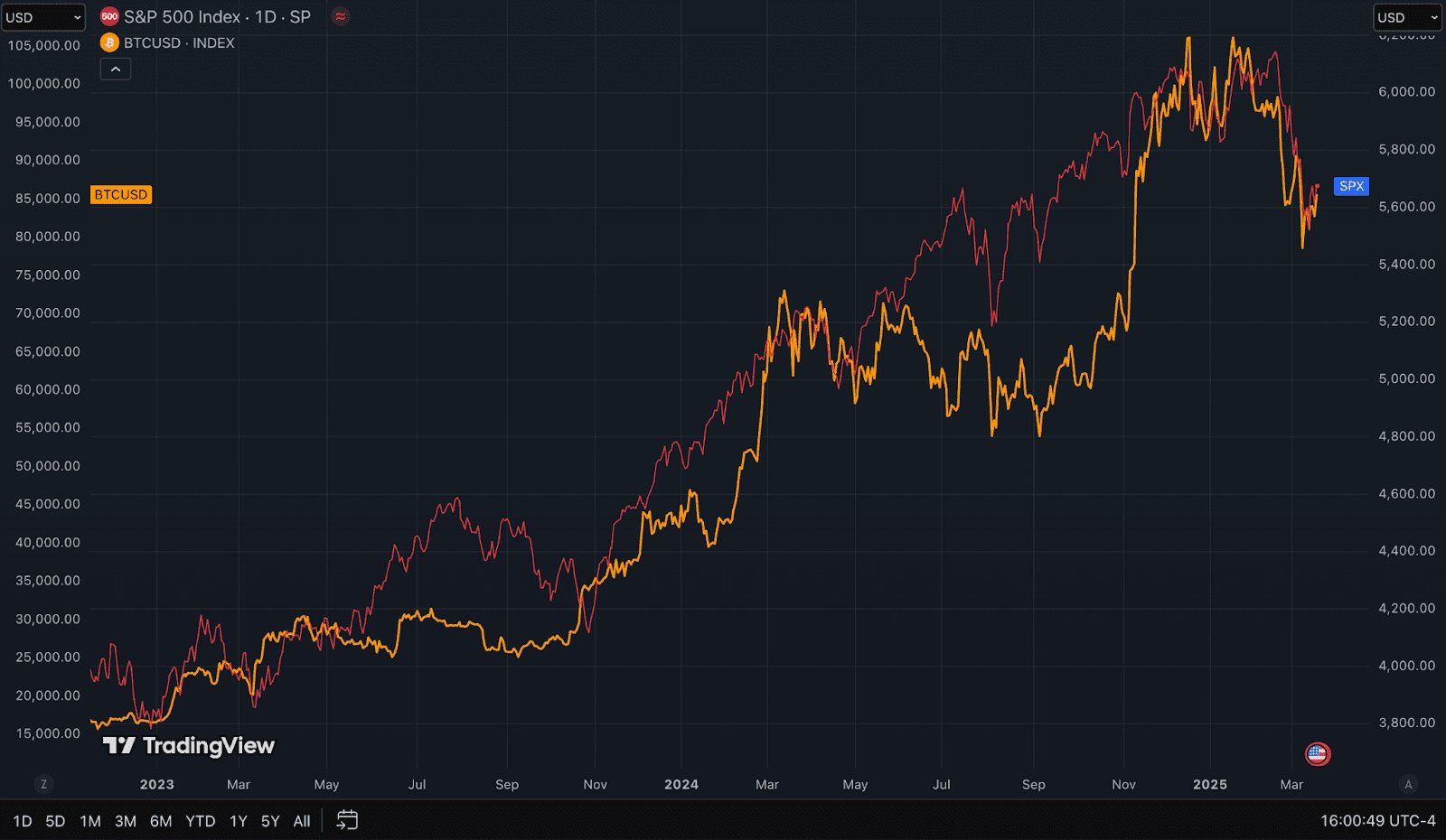
“So as we’re trying to determine where Bitcoin goes from here, the unfortunate truth is that it all probably depends on what happens to the major stock indices,” he noted
Davis also advised crypto investors to monitor the broader economy, the stock market, and the M2 money supply, both in the US and globally.
For now, the largest cryptocurrency continues to navigate volatility ahead of President Trump’s tariff announcement. In fact, BeInCrypto reported that spot Bitcoin ETFs have recorded outflows for three consecutive days.

On the price front, Bitcoin has dipped 3.1% over the past week. At press time, the coin was trading at $85,042, representing small gains of 0.8% over the past day.
Disclaimer
In adherence to the Trust Project guidelines, BeInCrypto is committed to unbiased, transparent reporting. This news article aims to provide accurate, timely information. However, readers are advised to verify facts independently and consult with a professional before making any decisions based on this content. Please note that our Terms and Conditions, Privacy Policy, and Disclaimers have been updated.
Bitcoin
Bitcoin to $250K? Hayes Links Price Surge to Fed’s QE Move

Arthur Hayes, former CEO of BitMEX, has predicted that Bitcoin (BTC) could soar to $250,000 by the end of the year.
However, this prediction is contingent on the US Federal Reserve (Fed) shifting its monetary policy toward Quantitative Easing (QE).
Bitcoin to $250,000, Hayes Predicts
Hayes argues that a halt in Quantitative Tightening (QT) and a return to liquidity injections would trigger a substantial Bitcoin rally.
“If my analysis regarding the interplay of the Fed, Treasury, and banking system is correct, then Bitcoin hit a local low of $76,500 last month, and now we begin the ascent to $250,000 by year-end,” read an excerpt in his latest blog.
This prediction hinges on his belief that central banks, particularly the Fed, will be forced to intervene to support financial markets, ultimately driving Bitcoin higher.
Further, the BitMEX co-founder directly ties Bitcoin’s potential price movement to the Fed’s approach to monetary policy. He argues that the central bank’s response to mounting fiscal pressures will lead to an end of QT and a de facto return to QE.
“Powell proved last week that fiscal dominance is alive and well and that he will do whatever it takes to ensure the Treasury can fund itself at reasonable rates. Therefore, I am confident QT, at least regarding treasuries, will stop in the short to medium term,” Hayes added.
Based on these, Arthur Hayes sees this as a pivotal moment for Bitcoin, emphasizing that the pioneer crypto would “scream higher once this is formally announced.”
Hayes also reinforced his confidence in the prediction, stating that his Bitcoin target is attainable as the bond market, banks, and Congress (which he terms BBC) will pressure the Fed into action.
British financial expert Raoul Pal supports the thesis of a bullish outlook for Bitcoin price. The former Goldman Sachs executive pointed to macroeconomic indicators that suggest a Bitcoin rally is imminent.
Raoul Pal shared a chart correlating the global M2 money supply and Bitcoin’s price. Based on history, Bitcoin tends to rise around 10 weeks after M2 increases, with Pal’s analysis suggesting that Bitcoin may soon enter a bullish phase.
“The waiting game is almost over…the 10-week lead is my preferred… but,” Pal remarked.
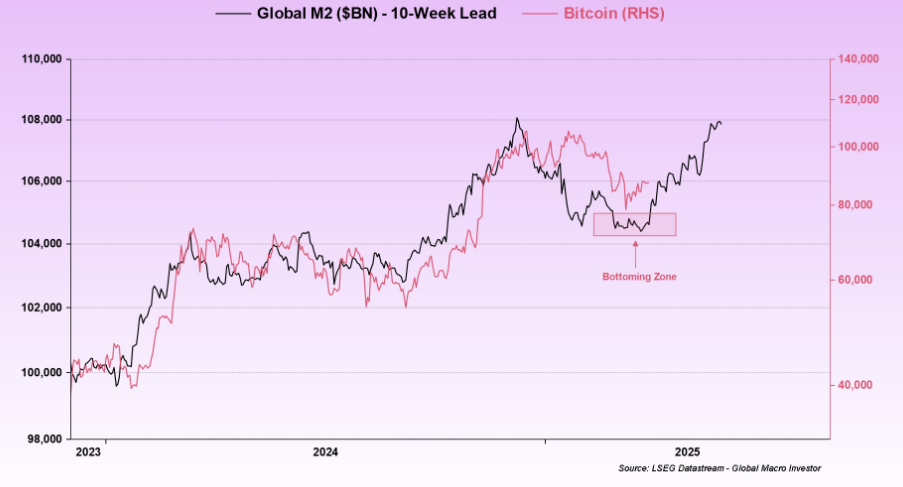
QCP Capital’s Stagflation Warning
Adding another layer to the macroeconomic picture, analysts at QCP Capital warn that if stagflation takes hold, the Fed could lean toward hiking rates instead of cutting them. Such an action would complicate the bullish outlook for Bitcoin.
“Markets continue to price 2.5 cuts in 2025. The Fed finds itself in a tight corner with consumer confidence and soft data coming in weak which may portend weaker GDP in Q2. At the same time, tariff-induced inflationary pressures could start building after April 2,” the analyst wrote.
The optimism comes despite Bitcoin logging its worst first quarter (Q1) performance in seven years. This notwithstanding, analysts point to a bullish momentum, suggesting that a price recovery is on the horizon.
“Sellers have dried up, and buyers seem comfortable with current price levels – setting the stage for a structural supply shortage. April-May could turn into a consolidation zone – a calm before the next impulse,” stated market analyst Axel Adler Jr.
Veteran investors are also increasing their Bitcoin holdings, signaling a phase of accumulation that often precedes strong price rallies. Market data also indicates that declining selling pressure from Bitcoin holders is paving the way for a potential push toward $90,000.
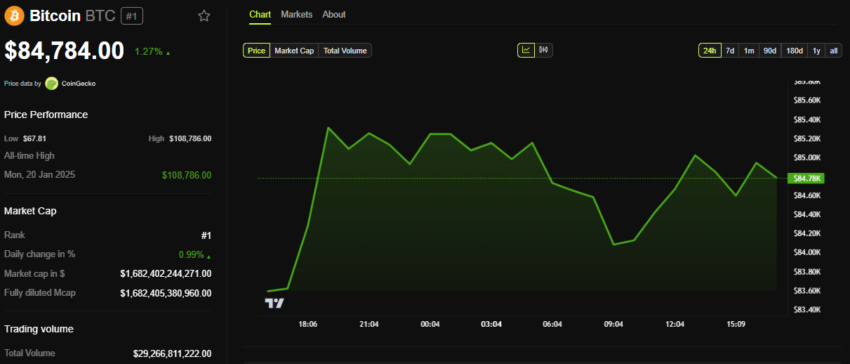
Meanwhile, Standard Chartered has noted Bitcoin’s growing role as an inflation hedge. This further solidifies the pioneer crypto’s place as a macroeconomic asset in uncertain financial times.
Nevertheless, as macroeconomic concerns continue challenging Bitcoin’s attractiveness, Gold is progressively presenting as an alternative store of value. BeInCrypto also reported that gold is outshining Bitcoin as a haven amid Trump’s 2025 tariff chaos.
Disclaimer
In adherence to the Trust Project guidelines, BeInCrypto is committed to unbiased, transparent reporting. This news article aims to provide accurate, timely information. However, readers are advised to verify facts independently and consult with a professional before making any decisions based on this content. Please note that our Terms and Conditions, Privacy Policy, and Disclaimers have been updated.
-

 Altcoin24 hours ago
Altcoin24 hours agoHere’s Why This Analyst Believes XRP Price Could Surge 44x
-

 Altcoin23 hours ago
Altcoin23 hours agoHow Will Elon Musk Leaving DOGE Impact Dogecoin Price?
-

 Ethereum21 hours ago
Ethereum21 hours agoWhy A Massive Drop To $1,400 Could Rock The Underperformer
-

 Altcoin20 hours ago
Altcoin20 hours agoFirst Digital Trust Denies Justin Sun’s Allegations, Claims Full Solvency
-

 Ethereum23 hours ago
Ethereum23 hours agoWhales Dump 760,000 Ethereum in Two Weeks — Is More Selling Ahead?
-

 Altcoin21 hours ago
Altcoin21 hours agoWill Cardano Price Bounce Back to $0.70 or Crash to $0.60?
-

 Market13 hours ago
Market13 hours agoXRP Price Under Pressure—New Lows Signal More Trouble Ahead
-

 Altcoin13 hours ago
Altcoin13 hours agoAnalyst Forecasts 250% Dogecoin Price Rally If This Level Holds
















